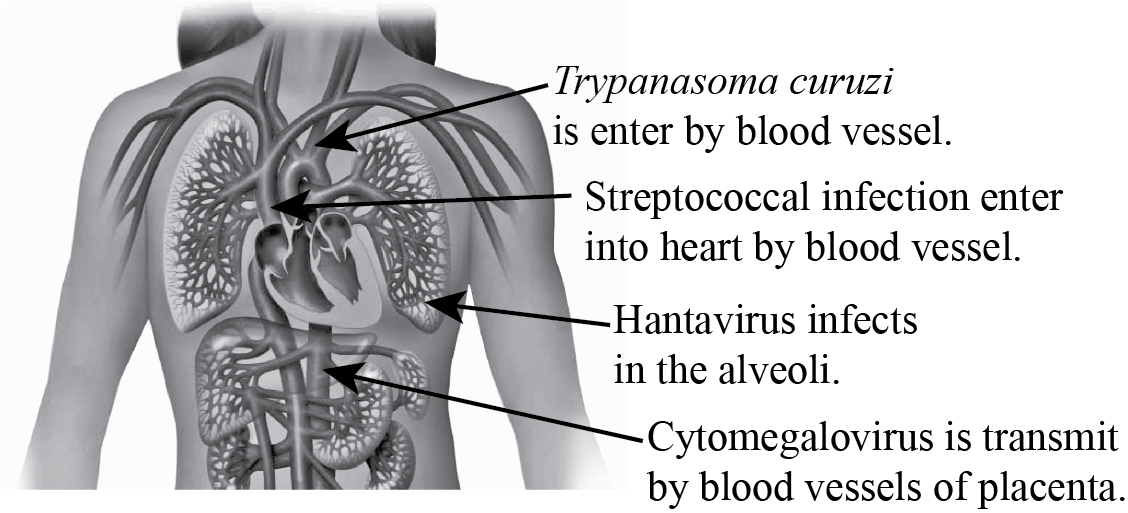
Identify the portals of entry for Trypanosoma cruzi, Hantavirus, and cytomegalovirus.

To review:
Streptococcal infection in the cardiovascular system and predict the entry of pathogens like Trypanosoma cruzi, Hantavirus, and cytomegalovirus into the pericardium.
Introduction:
Strep throat is a common infection caused by Streptococcal bacteria. Cytomegalovirus infects individuals with weak immune system and widely cause infections in infants. Trypanosoma cruzi cause Chagas disease and Hanta virus cause infection in pulmonary alveoli.
Explanation of Solution
Diagram:

Streptococcal infection mainly causes strep throat. Through blood vessels, the pathogen ultimately reaches the heart and cause infection in the cardiovascular system.
Cytomegalovirus is a form of herpes virus. It infects the person with weak immune system and it remains in humans throughout the life time. Mostly, it infects pregnant women and infants. This infection may also lead to miscarriages. Some of the symptoms are tiredness, fever, and fatigue.
Chagas disease is caused by Trypanosoma cruzi. This protozoa enter into the blood stream and infects other cells. Triatomine bug is an insect vector which helps in the transmission of disease. Swelling of the eyelid is a typical sign of Chagas disease. In the chronic phase of the disease, the infected individual develops symptoms like enlargement of the ventricles. This ultimately results in heart failure.
Hantavirus, also called as orthohantavirus, is a single stranded RNA virus that infects the humans. It mainly infects the alveoli of the lungs. This condition is known as a Hantavirus pulmonary syndrome. Hantavirus also has a tendency to affect the kidneys and heart, and ultimately hinder the proper functioning of these organs.
Trypanosoma cruzi, Hantavirus and cytomegalovirus infects the cardiovascular system and their entries are shown in the diagram.
Want to see more full solutions like this?
Chapter 23 Solutions
Microbiology: An Introduction Plus Mastering Microbiology with Pearson eText -- Access Card Package (13th Edition) (What's New in Microbiology)
Additional Science Textbook Solutions
Biology: Life on Earth with Physiology (11th Edition)
SEELEY'S ANATOMY+PHYSIOLOGY
Organic Chemistry
Fundamentals Of Thermodynamics
Laboratory Manual For Human Anatomy & Physiology
- Noggin mutation: The mouse, one of the phenotypic consequences of Noggin mutationis mispatterning of the spinal cord, in the posterior region of the mouse embryo, suchthat in the hindlimb region the more ventral fates are lost, and the dorsal Pax3 domain isexpanded. (this experiment is not in the lectures).a. Hypothesis for why: What would be your hypothesis for why the ventral fatesare lost and dorsal fates expanded? Include in your answer the words notochord,BMP, SHH and either (or both of) surface ectoderm or lateral plate mesodermarrow_forwardNot part of a graded assignment, from a past midtermarrow_forwardNot part of a graded assignment, from a past midtermarrow_forward
- please helparrow_forwardWhat does the heavy dark line along collecting duct tell us about water reabsorption in this individual at this time? What does the heavy dark line along collecting duct tell us about ADH secretion in this individual at this time?arrow_forwardBiology grade 10 study guidearrow_forward
- Health Safety And Nutrition F/Young ChildHealth & NutritionISBN:9781305144767Author:MAROTZPublisher:Cengage
 Medical Terminology for Health Professions, Spira...Health & NutritionISBN:9781305634350Author:Ann Ehrlich, Carol L. Schroeder, Laura Ehrlich, Katrina A. SchroederPublisher:Cengage Learning
Medical Terminology for Health Professions, Spira...Health & NutritionISBN:9781305634350Author:Ann Ehrlich, Carol L. Schroeder, Laura Ehrlich, Katrina A. SchroederPublisher:Cengage Learning  Comprehensive Medical Assisting: Administrative a...NursingISBN:9781305964792Author:Wilburta Q. Lindh, Carol D. Tamparo, Barbara M. Dahl, Julie Morris, Cindy CorreaPublisher:Cengage Learning
Comprehensive Medical Assisting: Administrative a...NursingISBN:9781305964792Author:Wilburta Q. Lindh, Carol D. Tamparo, Barbara M. Dahl, Julie Morris, Cindy CorreaPublisher:Cengage Learning





